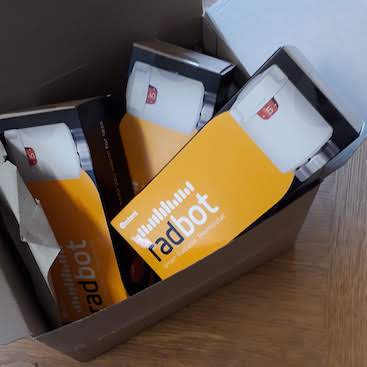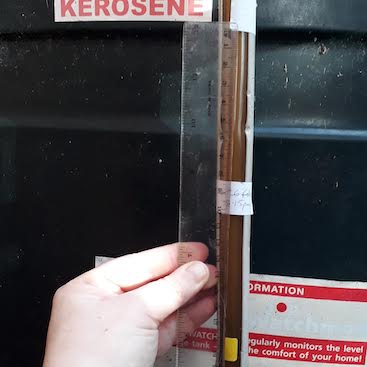Disclaimer: I was sent three Radbots for the purposes of this review, but all views are my own.

Radbot in action
In my quest to cut our heating costs, I have a new love, and its name is Radbot.
Never thought I’d get carried away by radiator valves, but these babies are clever.
Get this: Radbots learn when you use the rooms in your house, and then heat each room only when you need it, saving money and energy. Vestemi, the company that makes Radbots, reckon they can save up to 30% on your energy bills, and they’re endorsed by the Energy Saving Trust.
Even better – Radbots are EASY. All you have to do is fit them, then they do everything else. Set and forget. No wi fi codes, no passwords, no programming, no smart hub, no app to swear at grapple with. Magic, I tell you.
I’ve blogged before about how we braced ourselves for more expensive energy bills after moving to the country. Much as I love our house, it’s far from energy efficient. Yup, the Georgians weren’t big on PVC double glazing or cavity wall insulation.
Previous post: Cheap ways to cut the cost of keeping warm
But even if you live in a well-insulated home, you might still want to shrink your bills and reduce your environmental impact.
So Radbots sound great – but do they actually work?
The nice people at Vestemi sent me three Radbots to try. Read on to find out how I got on!
Table of Contents
Why heat the whole house?
One of my bug bears is central heating thermostats. (Yes, I am the life and soul of any party).
Who wants to burn cash heating their whole house to the same temperature all at the same time? We use different rooms at different times of day.
Any parent who’s nagged their kids about turning off lights knows it’s a waste of money leaving lights on with no-one to benefit. Shouldn’t heating be the same?
So after moving in, we got thermostatic radiator valves (TRVs) fitted on our radiators. They’re great for turning heating right down in rooms we don’t use very often – like the spare room, for example. But elsewhere, it’s more tricky. My husband whacks the valves off when leaving rooms, to save money. I get fed up with switching valves back on when entering a chilly room, then waiting ages for the temperature to rise. And I think we’re both scared of programming the central heating system.
I did try getting Nest, dreaming of a device that would learn when we needed our heating on and off. But it still wanted to heat our whole house to the same temperature. Plus, the engineer sucked his teeth and pointed out the wi fi signal couldn’t get through thick walls and floors to the boiler in the basement, and had to take it away again.
That’s where Radbots come in.

Exciting box of Radbots
Fitting Radbots
We were given three Radbots for this review, so I had to choose between the 11 radiators in our house, four of which are normally switched off.
I fitted the Radbots in the rooms we use most, but at different times of the day: our bedroom, the kitchen and the sitting room. My husband and I are in our bedroom overnight, then the kitchen gets used around meal times, the kids use the sitting room before school, and we all pile in during the evening.
I’ve got to be honest – I was nervous about installing the Radbots, as I’m distinctly lacking in DIY skills. The website reckoned that if you already have thermostatic radiator valves, you can fit them yourself. If you don’t have TRVs, you’ll need a proper plumber or heating engineer.
But once I plucked up the courage, fitting only took a few minutes.
The instructions and diagrams in the quick reference guide were nice and clear. The only tool I used was a tea towel, to get a good grip on the old valves when twisting them off. Radbots come in a box with six different adaptors for different radiator models, so you can find the adaptor that fits. After I put the batteries in the back, I was slightly worried as the Radbot started clicking and flashing, but you just screw it onto the radiator, press the boost button on top, and done.
Full marks to Radbot for well designed packaging and instructions. The radiator adaptor ring most likely to fit is put on the top of the box, so you can try it first, and batteries are included!
How to use Radbots
There are only two controls to worry about: the temperature dial and the boost button.
1. Temperature dial
You twist the ring on top to set the temperature you want when using the room.
The dial comes set a 3, which is 19 degrees centigrade, but there are five settings plus a flame symbol for max 24 degrees and a frost symbol if you basically want the radiator turned off, but don’t want the temperature to fall so low the pipes freeze.
2. Boost button
Meanwhile if you come into a room and it feels a bit chilly, you just press the boost button on top of the Radbot. It flashes red and whacks up the temperature for 30 minutes, before returning to the normal setting. I loved this function. Before, if we needed extra heat, I had to turn up the TRV and usually forget to turn it down again, or traipse down to the basement to hit the ‘extra hour’ button on the central heating controls. Now, I just press the boost button by the radiator, and it only affects a single room.
In theory, set the temperature dial once, and you’re good to go. Afterwards, just use the boost button if you’d like the room to be warmer, and wait for the Radbots to learn when you need the radiator on.

How cute is that Pacman logo? Picture credit: Radbot
How do they work?
Radbots come with stern instructions about needing access to light and air. (Reminded me of rules about caring for Gremlins: Don’t get them wet! Don’t feed them after midnight!!).
It’s no good installing Radbots behind curtains, radiator panels or shut away behind furniture. You can’t use them with more unusual forms of central heating, such as ground source or air source heat pumps. Also, you can’t fit them in rooms with high humidity or where they might get wet, so I can’t unleash them on the heated towel rails in our bathrooms.
We got a bit of a shock the first time the Radbot in the corner of the kitchen clicked into action, but we soon got used to occasional short bursts of clicks.
Otherwise, we did wonder how on earth Radbots actually work, spotting when we use rooms and learning when we want the heating on. The instructions and website are a bit cagey, so I asked Jeremy Lock, CEO at Vestemi.
He explained that each Radbot contains three sensors, to measure changes in light, temperature and humidity. The Radbot works out when people are in a room by changes in light. The little ‘calculation model’ inside then remembers when you open curtains or switch on the lights, uses artificial intelligence and algorithms to build up patterns, and adjusts the heating accordingly. Apparently they should generate their first set of data in 24 to 48 hours, then take 7 to 10 days to ‘build up an understanding of your patterns’ (ie don’t expect them to get it all right instantly).
When the Radbot detects that there aren’t any people in the room, it saves energy by letting the temperature drop by a few degrees. The lower you set the main temperature control, the more degrees it lets the temperature fall in empty rooms, and the more money you can potentially save.
Jeremy confirmed that if for example you use your home differently during the week and at weekends, the Radbots will learn that. Magic, as I said.
In practice, it was really weird finding the radiator pretty cold if I ever got up in the middle of the night, but then blasting away just before my husband normally gets up in the morning, without having to programme the central heating.
I really liked knowing the rooms would heat up in use, and cool down when empty, without me having to do anything. No turning valves on and off, no programming, the Radbots just did it for us. The only thing I ever do is hit the boost button if a room seems a bit chilly.

High tech energy measuring
How much did we save with Radbots?
Ideal world, if I was trialling Radbots I’d have gas central heating and take nice readings from the gas meter before and after using them.
But we don’t. We have an oil boiler. Want to know how much oil we’ve got left? Go and stare at the plastic tube up the side of it.
So measuring our energy consumption involved me crammed in beside the oil tank in the front garden, putting stickers on the oil level at the start, and using a ruler to measure how far it fell.
Ideal world, I wouldn’t also discover the oil tank was almost empty, and have to order a new delivery pdq. Still, at least it means I now know how much 1,000 litres measures in our tank (45.2cm, I’m sure you’ll be glad to know).
Previous post: How to cut the cost of heating oil
So after the oil delivery, I measured the oil level before and after using our central heating normally for 13 days, and then again after 13 days with Radbots fitted on three radiators.
Turns out with normal central heating, we used 10.3cm of oil and with Radbots, we used 9.1cm.
That 1.2cm difference might not sound like much. But it’s 11.7% less. Our last oil delivery cost £520 for £1,000 litres, so we saved £13.80 when using Radbots. That’s just over a £1 a day during winter weather! If we have the heating on for six months of the year, that would save more than £180 at current oil prices.
We might well have seen an even higher percentage saving with Radbots fitted on more radiators. Anyone living in smaller, better insulated house might also see a higher percentage saving, if less heat escaped.
How much do Radbots cost?
So the Radbots definitely cut our heating bills – but how much do they cost?
They are distinctly more expensive than ordinary manual thermostatic radiator valves. Cheapo TRVs might sell for as little as £7 each if you’re buying a bucket load from a plumbers’ merchant.
Over on the Vestemi website, Radbots normally sell for £64.99 each, dropping to £48.74 each when buying four or more.
But Much More With Less readers can get a chunky 25% off using the code mml25 here.
This takes the price down to £48.74 each, or £36.56 each when buying four or more.
And just to be clear, that is not an affiliate link – I don’t get any cut if you buy Radbots, I just think they’re a great product.
The good news is that Radbots come with a two year warranty and if you ever move house, you can just unscrew the valves and take them with you.
Overall
I was given three Radbots to trial for free, but even if I’d paid full price, it looks like they would have paid for themselves in less than a year. Certainly, I was sufficiently impressed that I have already ordered four more.
I like Radbots because they cut our heating costs by more than 10% and were incredibly simple to use. Plus, my husband doesn’t go round turning radiators off any more, so they’re great for marital harmony.
Sure, people who would like more control of their heating, programming exactly when it should turn on and off and poring over the results might prefer a different product. (I call those people ‘men’). Nor can you turn Radbots on remotely, using a smart phone, if you’ve been away – although you can use them with Hive and Nest hubs for extra savings.
But for me, the big attraction is that once in place, Radbots learnt when our heating needs to be on and off without me doing anything else at all.
Now – over to you. What do you think of Radbots? I really do recommend them.
Pin for later:

I really need this kind of information and must share it with my circle. Thanks for sharing this with us.
I just want to say Thank You to everyone who supported me through the years. My name is Manuel Franco, New Berlin, Wisconsin. My story of how I won the Powerball lottery of $768.4M is a bit of a tale. I have been playing Powerball tickets for 6 years now since I turned 18. I bought my first ticket on my 18 birthday. I was feeling very lucky that day because I had contacted Dr. Odunga Michael to help me with the winning Powerball numbers. I really had that great great feeling that I looked at the camera wanting to wink at it. I only did a tiny part of it and trusted him. He gave me the numbers after I played a couple other tickets along with it for $10. I checked my ticket after the winnings came online and saw the numbers were correct including the Power play. I screamed for about 10 minutes because it felt like a dream. I had won $768.4M. You can check my winning testimony with the lottery officials just with my name search. Thank you Dr Odunga. Well, his email is odungaspelltemple@gmail.com and you can also call or Whats-app him at +2348167159012 so you guys can contact him
Investing on the cryptocurrency market has been a main source of income, that’s why knowledge plays a very important role in humanity, you don’t need to over work yourself for money.All you need is the right information, and you could build your own wealth from the comfort of your home!Binary trading is dependent on timely signals, assets or controlled strategies which when mastered increases chance of winning up to 90%-100% with trading. It’s possible to earn $10,000 to $20,000 trading weekly-monthly in cryptocurrency(bitcoin) investment, just get in contact with Mr Bernie Doran my broker. I had almost given up on everything about binary trading and never getting my lost funds back, till i met with him, with his help and guidance now i have my lost funds back to my bank account, gained more profit and I can now trade successfully with his profitable strategies and software!!
Reach out to him on Gmail (BERNIEDORANSIGNALS@GMAIL.COM) , or his WhatsApp : +1(424)285-0682 for inquiries